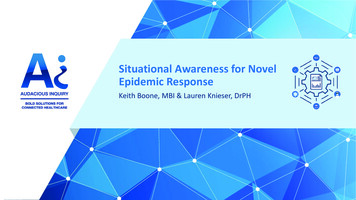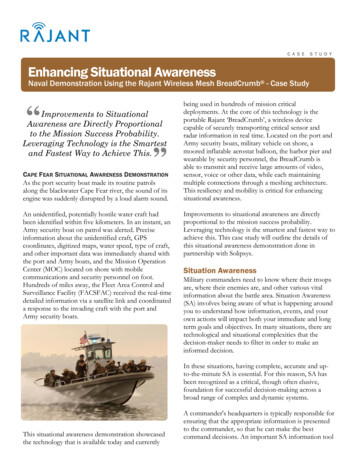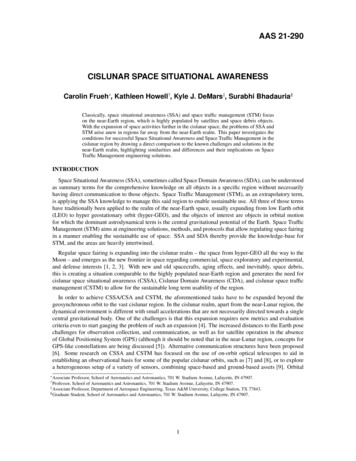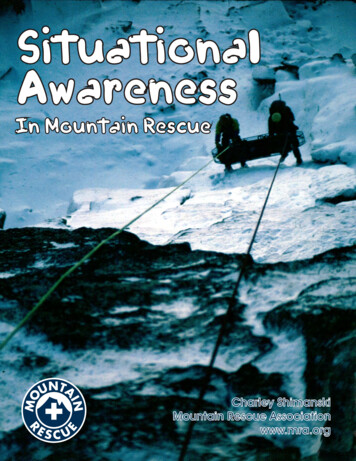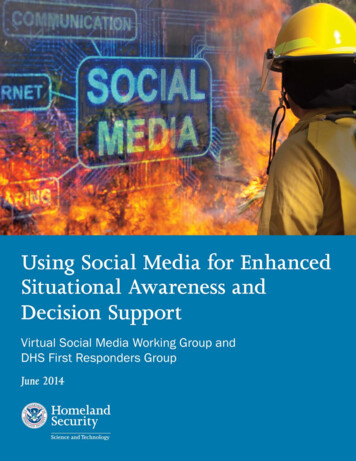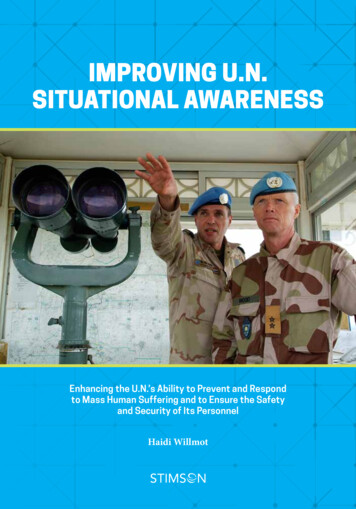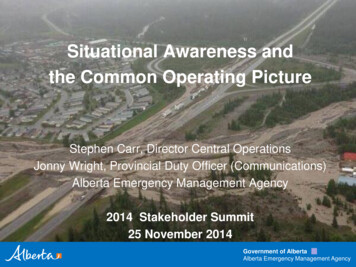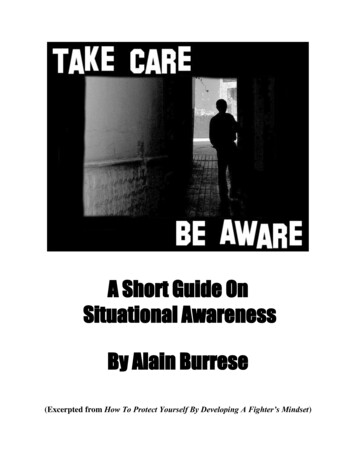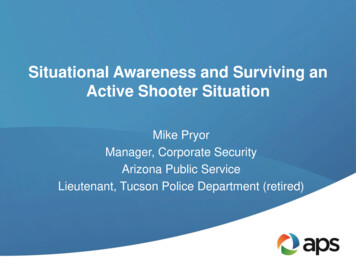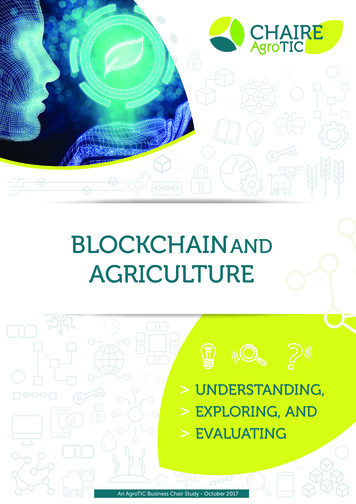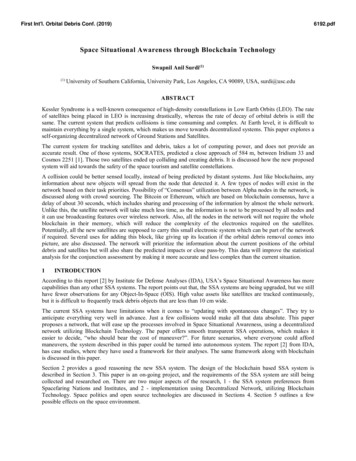
Transcription
First Int'l. Orbital Debris Conf. (2019)6192.pdfSpace Situational Awareness through Blockchain TechnologySwapnil Anil Surdi(1)(1)University of Southern California, University Park, Los Angeles, CA 90089, USA, surdi@usc.eduABSTRACTKessler Syndrome is a well-known consequence of high-density constellations in Low Earth Orbits (LEO). The rateof satellites being placed in LEO is increasing drastically, whereas the rate of decay of orbital debris is still thesame. The current system that predicts collisions is time consuming and complex. At Earth level, it is difficult tomaintain everything by a single system, which makes us move towards decentralized systems. This paper explores aself-organizing decentralized network of Ground Stations and Satellites.The current system for tracking satellites and debris, takes a lot of computing power, and does not provide anaccurate result. One of those systems, SOCRATES, predicted a close approach of 584 m, between Iridium 33 andCosmos 2251 [1]. Those two satellites ended up colliding and creating debris. It is discussed how the new proposedsystem will aid towards the safety of the space tourism and satellite constellations.A collision could be better sensed locally, instead of being predicted by distant systems. Just like blockchains, anyinformation about new objects will spread from the node that detected it. A few types of nodes will exist in thenetwork based on their task priorities. Possibility of “Consensus” utilization between Alpha nodes in the network, isdiscussed along with crowd sourcing. The Bitcoin or Ethereum, which are based on blockchain consensus, have adelay of about 30 seconds, which includes sharing and processing of the information by almost the whole network.Unlike this, the satellite network will take much less time, as the information is not to be processed by all nodes andit can use broadcasting features over wireless network. Also, all the nodes in the network will not require the wholeblockchain in their memory, which will reduce the complexity of the electronics required on the satellites.Potentially, all the new satellites are supposed to carry this small electronic system which can be part of the networkif required. Several uses for adding this block, like giving up its location if the orbital debris removal comes intopicture, are also discussed. The network will prioritize the information about the current positions of the orbitaldebris and satellites but will also share the predicted impacts or close pass-by. This data will improve the statisticalanalysis for the conjunction assessment by making it more accurate and less complex than the current situation.1INTRODUCTIONAccording to this report [2] by Institute for Defense Analyses (IDA), USA’s Space Situational Awareness has morecapabilities than any other SSA systems. The report points out that, the SSA systems are being upgraded, but we stillhave fewer observations for any Object-In-Space (OIS). High value assets like satellites are tracked continuously,but it is difficult to frequently track debris objects that are less than 10 cm wide.The current SSA systems have limitations when it comes to “updating with spontaneous changes”. They try toanticipate everything very well in advance. Just a few collisions would make all that data absolute. This paperproposes a network, that will ease up the processes involved in Space Situational Awareness, using a decentralizednetwork utilizing Blockchain Technology. The paper offers smooth transparent SSA operations, which makes iteasier to decide, “who should bear the cost of maneuver?”. For future scenarios, where everyone could affordmaneuvers, the system described in this paper could be turned into autonomous system. The report [2] from IDA,has case studies, where they have used a framework for their analyses. The same framework along with blockchainis discussed in this paper.Section 2 provides a good reasoning the new SSA system. The design of the blockchain based SSA system isdescribed in Section 3. This paper is an on-going project, and the requirements of the SSA system are still beingcollected and researched on. There are two major aspects of the research, 1 - the SSA system preferences fromSpacefaring Nations and Institutes, and 2 - implementation using Decentralized Network, utilizing BlockchainTechnology. Space politics and open source technologies are discussed in Sections 4. Section 5 outlines a fewpossible effects on the space environment.
First Int'l. Orbital Debris Conf. (2019)26192.pdfNEED FOR A NEW SSA SYSTEMThe need for cooperation among operators and the inherent problems of mutual trust have been widely recognized inthe literature [3][4], which was one of the reasons for creating Space Data Association [5]. For the Space DataAssociation’s data center, there are several membership requirements and benefits such as Conjunction Assessment,RF interference, geo-location support and authoritative contact information for a given space object. It is importantto note that it’s a centralized solution, which means a central point of failure and ability to be controlled by singleentity. Many companies are reluctant to share information about their satellites [2]. Even with official contracts, it isdifficult for them to trust such a Data Center. Along with such trust issues, there’s also some cost associated with it.The blockchain based solution offers more transparency and hence will aid towards building that trust. Asblockchain is decentralized, the cost of building the system is proportionately divided, along with incentives orprofits.With increasing capabilities of SSA technologies, it is going to be difficult to hide space assets [2]. Certain measurescould be taken in the network to maintain a level of anonymity. Once an object is detected in Space, it is importantto identify it to contact the owner in case of a predicted collision. The blockchain solution offers anonymity andidentification as well. It will be possible to associate the object detected to a network node, but the node may or maynot declare its identity.Currently only a few of the low earth orbits are crowded, but soon there will be more space traffic. The space aroundthe Earth will be occupied by various types of satellites, debris, and spaceships containing humans. The ISS, inLEO, spends substantial amount of resources to avoid collision with OIS. Kessler described a scenario where acollision in densely crowded space, will start a cascading chain reaction of collisions [6]. Currently the time betweentwo collisions is very low as number of objects in space are low, compared to the space available. As we launch newsatellites and spaceships, state-of-the-art technology will be used in that. A more rigid material will be used toprotect assets in space. These will protect them from space debris and meteoroids. It is possible that one of thesecould turn into space debris, and we won’t be able to afford getting hit by such an object.Companies like SpaceX, OneWeb, Swarm, are launching satellite constellations, that will cover the whole globe.Spectrum could be considered aa a limited resource. More companies will launch their constellations to provideservice to prospective customers. With wireless communication, we have observed that certain applications havereached the saturation density, based on the availability of the spectrum or ability to transmit in the frequencyranges. Limitations could be authority induced or being not able to design specific transmitters. Somewhere downthe line, we are going to hit the saturation for space as well. It may not stop the whole operation, but it will certainlyadd obstacles like interference, noise. One known limitation, that is currently being experienced by most of thecompanies is that there are different authorities/entities controlling the spectrum in sovereign states. In this paper,this issue is considered as limitations of Spectrum usage. For Radio communication, ITU-R maintains MIFR, whichincludes all the frequencies being used, and available. One of their goal is to maintain efficient use of the spectrum.For the future, ITU-R needs to develop more standards for the types of uses of spectrum in space. The systemdescribed in this paper, could use such standards.Ideally, we would use Radars to detect any incoming objects, but it is difficult to detect and track smaller objectsthat are coming towards spaceship with a relative speed, twice the orbital speed. Avoiding such objects orcountering, would have to be done in much less time. To counter this, what if satellites and spaceships broadcastsuch information collected from their radars. Similar technology is being considered for autonomous vehicles. Thevehicle in front of you provides information about vehicles in front if it.Let us consider one example scenario that happened in September 2019. There was a predicted collision betweenSpaceX’s Starlink 44 and ESA’s Aeolus [7]. From this scenario, two conclusions could be drawn. 1 - need forfrequent updates on accurate locations, which will make it easier to assess the collision risk, and 2 - Reliable and fastcommunication as well as coordination between involved parties. This scenario had only two parties involved, andyet there was a problem somewhere. If multiple parties get involved, the coordination process will become timeconsuming, and we may not have enough time to perform safe maneuvers. The requirements of a new proposed SSAsystem are enlisted below. These are based on various conclusions from scenarios such as the one described above.1.2.3.4.Frequent observations of objects.Frequently updating catalog and sharing new objects with the whole network in minimum time.Improved accuracy of observations.Faster referencing with Catalog of known objects.
First Int'l. Orbital Debris Conf. (2019)5.6.7.36192.pdfa. New satellites or spaceship could carry a beacon node that will make it easy for trackingb. Commercial Satellites, spaceship, that know their own location, should broadcast it periodically.A network protocol, that will enable optimized use of Spectrum.a. This protocol will co-exist with any protocol that is being used now, Software Defined Radiosincorporating beam-forming capabilities.b. There will be additional security as and when required by the network nodes.c. Ability to connect satellites of different organizations and facilitating information transfer alongwith resource sharing.Anonymity if requiredNew Architecture of Trust [3]BLOCKCHAIN AND DECENTRALIZED NETOWRKSBlockchain and decentralized networks offer unique capabilities. There are companies that are trying to utilizeblockchain based decentralized network to connect the whole Earth. Companies like SpaceChain [8] are developingopen-source blockchain networks that will operate in Space. It is difficult to sum up what is exactly happening inSpace. A decentralized network will help us connect the dots.Let us consider a network of satellites, ground stations, and potentially any device that has the capability ofconnecting to a wireless network. Let us call this network “Decentralized Horizon Network” (DHN). Some nodes inthe network will perform more tasks and contribute towards creation of blocks. This will make the blockchainnetwork a Consortium type [9]. Various aspects related to blockchain network are discussed below.3.1ConsensusThe network, as a whole, does not require consensus. There is no proof-of-work for all the nodes. If a sensingsatellite detects an object, it shares that information to the network. No other node will deny this information. On theother hand, it is possible that the same object is detected by another satellite and shared to the network. This willcreate duplicate entries. Here, there are two entities that would need consensus on the identity of the object. If theaccuracy of the reading, from both systems is correct, then it can be mathematically proved that the two readingsrepresent the same object and the newer reading will be used. There are different types of technologies that are usedto detect objects, like optical sensors or RADARs. It will create readings with different accuracies. Combining thesereadings generates more accurate/high quality orbits. A tool or method as described in this paper [10] could beutilised in the DHN. The combination and utilization may require consensus. Once all the satellites, ground stationsthat detect OIS, submit the data to DHN, we will be able to see an overview of available observations. It would bepossible to allocate specific ground stations to target certain objects that were not tracked correctly. Collectively, itwould improve the readings. This could also be a special request from the network, and the ground station orsatellite submitting that reading, will get (let’s say) more currency to perform that task. All the sensors (satellites orground stations) could gain consensus on tracking down objects, with more efficiency, and (potentially) coveringalmost everything in space.Once readings are collected, orbits will be predicted by different entities or nodes in the network. There are numberof ways to perform these predictions. Some universal constants are used for the predictions as well as for taking theorbital readings. Even if all the nodes in the network, use the same constant values, to the highest possible accuracy,we’ll still end up getting an inaccurate reading, leading to an inaccurate prediction. This happens because theconstants being used, are not exactly constant. For example, Gravitational constant has a relative uncertainty [11].Once all the data is collected, regarding satellite orbits, it’ll be possible to find out overlapping orbits. Here, theinvolved parties need a consensus on who will perform a manoeuvre to avoid collision.3.2BlockchainBlockchains store information in blocks that are connected with cryptographic hash. Each block contains acryptographic hash of the previous block, a timestamp, and transaction data. This is perfect for a ledger, where itneeds to store all the transactions as they occurred and must be immutable. In case of DHN, immutability will berequired to store orbital data corresponding to timeline.Consider figure 1 that shows sectoring of space around the Earth.
First Int'l. Orbital Debris Conf. (2019)6192.pdfFig. 1: Possible Sector DivisionIt is analogous to cellular network. Each sector will be pre-defined. Size of the sector will depend on some factorsrelated to spacecrafts and orbits. Consider the following type of sector. A hexagonal face is selected to cover thesurface of the Earth, like a soccer ball. Hexagon is the closest representation of a circle that could provide a regulartessellation. Radially outward lines are drawn through the vertices of the hexagons. Imagine concentric spheres ofradii R nL where n is a non-negative integer and L is length of the sector as shown in the Figure 2. Sectorproperty d is adjusted such that the time t spent by an object in a sector, will remain approximately same. The shapeof the sector is shown in figure 2.Fig. 2: Sector DesignIn this case of sector shape, it becomes a complex process of determining the sector as compared to cubical sector.Each sector will be associated with a time span t. The time-spans will be predefined epochs. Such sectors arereferred as “T-Sector”. Properties of t-sectors –1. Position around Earth, in Geocentric Celestial Coordinate System2. Area, Volume, and other sector specific information, that will not change over time3. Unique Identifier, Alphanumeric4. Caretakers, stakeholders if any5. Timestamp, and time span.6. Predictions if any.More research is required to define sectors. These definitions could be applied to any celestial body. Conventionalcoordinate systems could also be used to define sectors. In any system, we need a sense of orientation for thereference body. For example, setting the reference for the North pole and South pole, and setting the 0 longitudesomewhere on the body. It is important to create a reference system or define a convention which will automaticallydefine a reference. One of such convention is the definition of the North pole. This paper concerns primarily aboutthe Earth System, hence all the references are well known, which would be used to define the sectors.Blockchain hashing and immutability property will be used in maintaining t-sectors that correspond to differentepochs. For example, data for all the sectors is generated for epoch 1 and some Satellite Z decides to do a maneuverfrom epoch 5, it’ll broadcast that request to respective nodes, and the miner will add it to the blockchain. Based onthe time of maneuver, the miner will create a new branch or update existing branch from epoch 5.
First Int'l. Orbital Debris Conf. (2019)6192.pdfAfter collecting tracking data for object X, it’s orbit will be predicted, along with possibility of error, which is addedto consider perturbing forces. The egg shell of this predicted orbit will pass through a lot of sectors. Object X will beadded to each t-sector, that is touched by its egg shell. In this way, data will be generated. Let’s call the collection ofthis data, a catalog. This catalog has all such sectors and past-present-future time spans, with list of objects passingthrough at that time. Dividing the data into sectors, will make it easier to divide the computing power. The t-sectorsthat contain more than a certain number of objects, will be flagged. Different computing beta nodes could computedifferent sectors. It is possible to combine sectors of an orbit for convenience.Multiple nodes will detect same objects. Different readings of the same object could be resolved in several ways.Initially, an accepted deviation is established for the consensus. This will resolve a lot of issues related to orbitdetermination. This approach is not going for precise location of the tracked object, but an approximate sector forthe same. At the end of predictions, there will be a few entries in one epoch, where same object exists in multiple tsectors. This is where miner nodes will require a consensus. For the purposes of tracking and predicting collisions, itwould be a minor set-back. Unless the blocks are predicted to be congested, it will be safe to wait for the nextreading of that object. If the next reading is obtained, then the predictions will be altered, and hence the previousconsensus will not be valid or required.3.3Smart Contracts and Decentralized Autonomous OrganizationsThere are some processes that happen over a period of few days to few years, whereas some happen within minutes.The work of ITU, would fall under long run processes. Tracking and avoiding debris are short lived processes.A DAO for orbital position allocation could facilitate smooth space operations between space agencies. A spaceshipcould book a certain path through space at certain time, which would be avoided by others. This path will beselected based on the data available in DCH. Similarly, frequencies for special operations could be booked forusage. Every year, ITU-R has to resolve a lot of reports regarding interference on allotted frequencies. There were92 cases of harmful interference received in 2014 [12].3.4Gas, Currency and transmitting powerIn a conventional blockchain network, a currency is created in order to facilitate different operations andtransactions. From the initial judgement of the space network, it would be difficult to put incentives based onunknown factors and scenarios. Once the network usage, node performance and maintenance are thoroughlyexplored, transaction costs, mining rewards could be decided.Gas and its limits are used to pay for the use of resources of the node. Time and computing power decide the cost oftransactions. Conventional blockchain networks use internet as the backbone network. Hence if a node is offeringpower instead of transaction cost, it will not be able to pass it on through that network. It is possible to providepower along with a small transaction cost.Satellites in Sun-synchronous orbit have access to all the power they need, from the Sun. Rest of the orbits have aphase of eclipse somewhere in their orbit. Batteries are used to power the satellite in those eclipse times. These Sunsynchronous orbit satellites can provide power to other satellites via beam forming. In short, satellites that haveplenty of power, can pay by transmitting that power to the destination node. More research would have to be donefor such cases. If it is possible, it opens a large set of applications where satellites may not have to carry batteries atall. Circuits that get activated by beams and perform the task required.3.4.1 Energy Harvesting and Gas transferAs more satellites are launched, there’s more energy being transmitted by satellites. It is possible to use the RFambient energy for low power applications [13].3.5Network NodesThere have been a lot of types of implementations of blockchain networks. For the application described, a practicalapproach of designing a new type of network is required. If we consider the existing architectures that are already inspace, they mainly consist of networks of satellites that follow their own protocols. There are constellations beinglaunched for different consumer requirements. Each of these clusters have their own networks. In order to make useof these networks, an inter-network protocol would have to be designed. Based on the use cases, and nodes requiredto facilitate the network, nodes are divided into following types –
First Int'l. Orbital Debris Conf. (2019)6192.pdf(α) Full node, miner, broadcaster – Alpha Node(β) Special purpose nodes, routers, sensing satellites – Beta Nodes(γ) End user nodes, Spaceships, Satellites, Space Stations – Gamma NodesThe Gamma nodes would get served for all the purposes required. Beta and Gamma nodes do not have to carry thewhole blockchain or block set. There will be special contracts between Alpha and Beta nodes (service nodes). Therewill be a limited number of Alpha nodes, based on the communication availability on the node and reach of AlphaNodes. Redundancy could be introduced by adding sleeping Alpha node, which will get activated only if the Alphanode in certain area stops functioning. Alpha nodes will act like the backbone of the network. Service nodes willhave to keep some digital currency in holding for the service they are providing. These are essentially gettingincentives for the service, but if they fail to perform up-to the required mark, a penalty would be taken from them.This is where consensus will come into picture. In addition to this penalty, a reporting system will be implemented,where network nodes can report issues about other nodes that are either functioning incorrectly or faultycommunication. This will help in terms of building a metric for reliable communication. It can be used to set theincentive values. It is easy to abuse such a system, and hence security of this system needs to be exploredthoroughly.Satellites, or ground stations that track objects in space would be beta nodes, as their primary task is not related tofacilitation of the network. Similarly, the nodes that do data processing would also be beta nodes, which would beconveniently placed on Earth. If there’s a node in space, with extra computing power and battery power, then itwould be used for minute changes related to refining predictions. The Alpha nodes could perform beta nodeoperations. From Fig 2, Alpha nodes can act as Beta as well as Gamma.Storage is limited and expensive resource in space. For the network to operate smoothly, it would have to maintain afew past epochs and more future epochs. Technologies like Inter-Planetary File System (IPFS) will be useful to storeold blockchain data [14].For better tracking, a small device or tracker will be designed that could be placed on new satellites or objects. Thesatellite operators can turn it off at any point. This will make it easier to track down satellites and identify them.Such satellites or objects will be Gamma nodes in the network.Fig. 3: Venn diagram of network nodes
First Int'l. Orbital Debris Conf. (2019)3.66192.pdfSecurity, Trust and AnonymityThere are a lot of known issues regarding security in blockchain networks. In the case of DHN, protection of Alphanodes gets more priority than other nodes. Attacks on conventional blockchains are mainly because of the currencyor data involved with it. Those reasons won’t come into picture for the Orbital Debris. However, a network couldnot be left susceptible to threats. Various aspects of security are required to be explored.A mechanism of Growing trust would have to be implemented. When a new node joins the network, without humangetting involved, how could the network determine if the node is “good” or “bad”? Audits could be performed bynetwork nodes, that would create credibility metric for the node. Reporting could be used that will report issuesabout the nodes. These are preliminary ideas which will be tested with the network.3.7NETWORK ARCHITECTURE AND FRAMEWORKThe vision of the blockchain based SSA system matches with the framework described in the report [2] from theInstitute for Defense Analyses. The framework is shown in figure 4. The network nodes will interact with each otheron the application layer using blockchain protocols, along with some additional protocols.Fig. 4: Framework; credits: IDA [2]Blockchain will be involved in Data Sharing, Data Collection, Oversight and Coordination. It will provide DataProducts that will be used for “Oversight and Coordination”.DHN will have a backbone decentralized wireless mesh network of Alpha Nodes. For the initial deployment of thenetwork over a large scale, this backbone is required to facilitate operations. Developers will design the blockchainprotocol that serves the network. As blockchain is a fairly new software platform, having academics involved in theblockchain strategy system ensures that it is continually challenged and researched in varying disciplines.Miners, industry bodies and traders are the stakeholders for networking. In a conventional blockchain, priority isgiven to “verifying the transaction and gaining consensus on the same”, which starts a race for hashing. Gainingconsensus on processed data is much more important than consensus on detected object. This is the part where acollaborative effort is required from all data processing units. Current SSA systems don’t have an easy mechanismto do this. DHN would have to incorporate such networking between nodes.In order to incentivize this process, we need the exact resource utilizations. More research would have to be done onthis, to make it incentivize fairly. Until this incentive is not figured out, a yearly membership could be given to themembers of the network. This ensures smooth initial operations and aids in the development of the system. This issimilar to initial coin offering, where instead of tokens, unfettered access to the network is given to the nodes thatwill join.
First Int'l. Orbital Debris Conf. (2019)3.86192.pdfNETWORK PROTOCOLBlockchain networks mainly rely on some network architecture, that facilitates the connection between nodes. Forblockchain in space, there is no such network architecture. It would have to be built from scratch. There arecompanies that provide backbone to such architecture, but it would be more centralized solution. If a single entityowns the backbone of the network, there exists a central failure point. A new network protocol would have to bedesigned, that could be run with the assumption of multiple available channels. Unlike a centralized network, therecould be two simultaneous connections in a decentralized network. This is like an Ad-hoc wireless mesh network. Itdiffers from the Ad-hoc network in a way that there are different entities that own the nodes of the network. Aconventional Ad-hoc network gets a prior set-up time. For this space-based network, there should be some protocolthat will automatically configure the network. With addition of nodes, and changes in environment, it must adapt.Changes in environment could be a Solar Flare, or someone else using the frequencies that the network wassupposed to use. If a certain path of the network becomes unusable, it must be able to reach the node using adifferent path. These are computational challenges, as well as counter measures for known problems.More research is required on the pointing out the requirements of the network protocol. One important requirementcould be that it must use minimum bandwidth. With software defined radios, it is possible to transmit and receivesignals at different frequencies. It would be wise to build a protocol that could utilize more frequencies, if required.As the density in DHN grows, a single node will not have to communicate to distant nodes directly. The networkprotocol would have to incorporate such scenarios of various densities.3.9Network node on each satelliteWireless networks enable us to triangulate a signal. Based on the data from communication signal, it would bepossible to take a reading of orbital location. In this case, the reading of the object is not accurate, but there areseveral approximate readings. It will enable the sensing satellites to look into certain directions in order to get anaccurate reading of that object. Approximate readings could also be useful in the prediction of orbits, which will fillvarious blocks. As more readings are collected, the data would be refined, and fewer objects will exist in blocks. Anacceptable accuracy of the readings would have to be established.3.10 Secondary use cases and prioritiesSpaceships, Satellites and Space Stations will make use of DHN. These will provide currency or power foroperations. DHN can be a network of smaller DHNs, because of the inclusion of special purpose beta nodes. Thesenodes will allow the connection to external netwo
Space Situational Awareness through Blockchain Technology . Swapnil Anil Surdi (1) (1) University of Southern California, University Park, Los Angeles, CA 90089, USA, surdi@usc.edu . ABSTRACT . Kessler Syndrome is a well-known consequence of high-d
